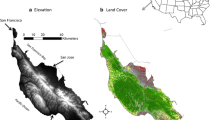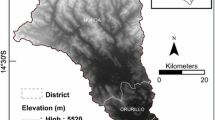Abstract
Coarse-scale, multitemporal satellite image data were evaluated as a tool for detecting variation in vegetation productivity, as a potential indicator of change in rangeland condition in the western U.S. The conterminous U.S. Advanced Very High Resolution Radiometer (AVHRR) biweekly composite data set was employed using the six-year time series 1989–1994. Normalized Difference Vegetation Index (NDVI) image bands for the state of New Mexico were imported into a Geographic Information System (GIS) for analysis with other spatial data sets. Averaged NDVI was calculated for each year, and a series of regression analyses were performed using one year as the baseline. Residuals from the regression line indicated 14 significant areas of NDVI change: two with lower NDVI, and 11 with higher NDVI. Rangeland management changes, cross-country military training activities, and increases in irrigated cropland were among the identified causes of change.
Similar content being viewed by others
References
Deering, D. W., Rouse, J. W., Haas, R. H. and Schall, J. A.: 1975, Measuring forage production of grazing units from Landsat MSS data. Proceedings of the 10th International Symposium on Remote Sensing of Environment, Ann Arbor, Michigan, 1169–1179.
Dick-Peddie, W. A.: 1993, New Mexico Vegetation: Past, Present, and Future, University of New Mexico Press, Albuquerque.
EROS Data Center: 1994, Conterminous United States AVHRR data on CD ROM–Users Manual. U.S. Department of Interior, EROS Data Center, Sioux Falls, SD.
Eastman, R. J. and Fulk, M.: 1993, ‘Long sequence time series evaluation using standardized principal components’, Photogrammetric Engineering and Remote Sensing 59(8), 1307–1312.
Eidenshink, J. C.: 1992, ‘The 1990 Conterminous U.S. AVHRR Data Set’, Photogrammetric Engineering and Remote Sensing 58, 809–813.
ESRI: 1996, Arc/Info and ArcView, Environmental Systems Research Institute, Inc., Redlands, California.
Fung, T. and LeDrew, E.: 1987, ‘Application of principal components analysis to change detection’, Photogrammetric Engineering and Remote Sensing 53(12), 1649–1658.
Goward, S. N., Dye, D. G. and Tucker, C. J.: 1985, ‘North American vegetation patterns observed by NOAA-7 AVHRR’, Vegetatio 64, 3–14.
Goward, S. N., Markham, B., Dye, D. G., Dulaney, W. and Yang, J.: 1991, ‘Normalized Difference Vegetation Index measurements from the AVHRR’, Remote Sensing of Environment 35, 257–277.
Goward, S. N., Waring, R. H., Dye, D. G. and Yang, J.: 1993, ‘Ecological remote sensing at Otter: satellite macroscale observations’, Ecological Applications 4, 322–343.
Gray, T. I. and McCrary, D. C.: 1981, Meteorological satellite data-A tool to describe the health of the World's agriculture. AgRISTARS Report EW-NI-04042, JSC, Houston, Texas.
Hirosawa, Y., Marsh, S. E. and Kliman, D. H.: 1996, ‘Application of standardized principal analysis to land-cover characterization using multitemporal AVHRR data’, Remote Sensing of Environment 58, 267–281.
Holben, B. N. and Justice, C. O.: 1981, ‘An examination of spectral band ratioing to reduce the topographic effect on remotely sensed data’, International Journal of Remote Sensing 2, 115–121.
Huete, A. R. and Tucker, C. J.: 1991, ‘Investigation of soil influences in AVHRR red and near-infrared vegetation index imagery’, International Journal of Remote Sensing 12, 1223–1242.
Justice, C. O., Townshend, J. R. G., Holben, B. N. and Tucker, C. J.: 1985, ‘Analysis of the phenology of global vegetation using meteorological satellite data’, International Journal of Remote of Remote Sensing 6, 1271–1381.
Myneni, R. B., Ganapol, B. D. and Asrar, G.: 1992, ‘Remote sensing of vegetation canopy photosynthetic and stomatal conductance efficiencies’, Remote Sensing of Environment 42, 217–238.
NOAA: 1986, NOAA polar orbiter user's guide. National Oceanic and Atmospheric Administration, National Environmental Satellite, Data and Information Service, National Climate Data Center, Satellite Data Services Division, Washington, D.C.
Townshend, J. R. G. and Tucker, C. J.: 1981, Utility of AVHRR of NOAA 6 and 7 for Vegetation Monitoring. Proceedings of Matching Remote Sensing Technologies and Their Applications(Reading, England: Remote Sensing Society).
Tucker, C. J.: 1979, ‘Red and photographic infrared linear combinations for monitoring vegetation’, Remote Sensing of Environment 8, 127–150.
Tucker, C. J., Vanpraet, C. L., Boerwinkle, E. and Easton, A.: 1984, ‘Satellite remote sensing of total dry matter accumulation in the Senegalese Sahel’, Remote Sensing of Environment 13, 461–469.
Warren, P. L. and Hutchinson, C. F.: 1984, ‘Indicators of rangeland change and their potential for remote sensing’, Journal of Arid Environments 7, 107–126.
Author information
Authors and Affiliations
Corresponding author
Rights and permissions
About this article
Cite this article
Minor, T.B., Lancaster, J., Wade, T.G. et al. Evaluating Change in Rangeland Condition using Multitemporal AVHRR Data and Geographic Information System Analysis. Environ Monit Assess 59, 211–223 (1999). https://doi.org/10.1023/A:1006126622200
Issue Date:
DOI: https://doi.org/10.1023/A:1006126622200




